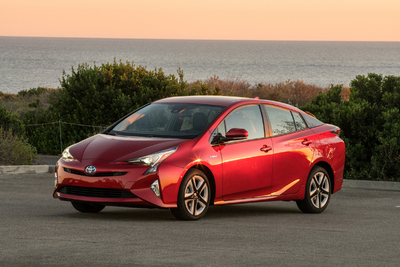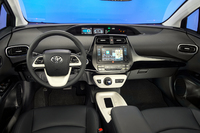2016 Toyota Prius Liftback Four Review by Carey Russ +VIDEO
 |
Much improved - No longer just a car for people who hate cars
DRIVING DOWN THE ROAD WITH CAREY RUSS
• SEE ALSO: Toyota Research and Buyers Guide
There’s “all-new” and then there’s really all new. The fourth-generation 2016 Toyota Prius Liftback is the most-changed in the car’s history, and meant to attract people who previously wouldn’t have considered a hybrid as well as hybrid aficionados. There’s even a Sport mode.
It’s longer, lower, wider, more powerful — and also lighter and more efficient. Its looks combine influences from Toyota’s Mirai hydrogen fuel cell car with Prius cues, and it’s still a useful five-door hatchback. Under the skin, the 2016 Prius is based on Toyota’s New Global Architecture (TNGA), a holistic concept for chassis and powertrain development and integration. Sitting on the same 106.3-inch wheelbase as previously, the body is 2.4 inches longer, 0.6 inches wider, and 0.8 inches lower than the previous generation. That’s not enough to negatively impact maneuverability or ease of parking, and the new structure features independent rear suspension for the first time in a Prius. In common with other newer Toyotas, careful suspension and steering calibration make the new Prius a pleasant car to drive, not a mere transportation appliance.
My first drive in a new Prius came at an automotive journalists’ ride-and-drive event with machinery from nearly all manufacturers. I’d just gotten back to base after a spirited drive on Central California coastal hill backroads in an Alfa Romeo 4C Spider. It was uncompromising, stiff, loud, not at all happy going slow, and with ergonomics from the people who brought you pointy-toed shoes. In other words, pretty much what I expected, and I got out with a big grin on my face. (disclaimer: I’m a sucker for Italian machinery, with multiple Italian motorcycles in the garage.) What was available next? Ah, a new Prius. “This should be interesting,” I thought, as the two should be about as far apart in character as is possible on four wheels.
Surprise! The Prius drove very well, with very good suspension and steering response. No, it wasn’t as quick as the Alfa, taking maybe twice as long to get to 60 mph, and it didn’t go uphill nearly as well, but it was not at all out of its element pushed a bit in the tight and twisty parts of the road. On low-rolling resistance tires at that. Not what I expected at all, a very pleasant surprise. And the interior is a vast improvement over that of any earlier Prius.
Trim levels (grades in Toyota’s terminology) are Two, Two Eco, Three, Three Touring, Four, and Four Touring. Standard equipment level is high, even on the Two, with pretty much everything you’d need in the way of comfort and connectivity amenities. Aerodynamic tweaks and lighter weight give the Eco a slight boost in fuel economy, EPA 58 city, 53 highway, 56 overall versus 54/50/52 for the others.
My test car was the same one I’d driven earlier, a Four in the new “Hypersonic Red” signature color, with the Premium Convenience Package (navigation system, larger information monitor, JBL audio system, sonar parking assist and more) and the Advanced Technology Package of moonroof, head-up display, and electronic safety assistance systems. Call it high-tech, comfortable, eminently functional, quiet, fuel-efficient — to the tune of 51mpg, much in Sport mode — and fun. Fun? Did I just use that word in connection to a Prius? Yep! It has matured from an early-adopter technology symbol long ago into a pleasant and useful car.
APPEARANCE: Origami in sheetmetal? If the new Prius looks strikingly-different at first glance, a closer inspection shows it to be not all that different in profile. It’s a little longer and sleeker-looking, and the high point of the roof has been moved almost seven inches forward for improved aerodynamics. Its 0.24 coefficient of drag is exemplary. The tip of the nose is significantly lower, better for both aero and forward visibility. Upward-trending character lines on the sides give it a dynamic, wedge-shaped look. Blacked-out C pillars make the roof appear to float over the body. The signature double rear hatch window remains, for good rear visibility. It is now flanked by angular vertical taillights. LEDs are used for all exterior lighting.
 |
COMFORT: As different as the new Prius’s exterior may be, compared to its predecessor, the interior is even more so. The basic layout is familiar, with the instruments in the center of the top of the dash for decreased eyestrain. The infotainment systems are controlled through the touchscreen in the center stack. The electronic shifter is at the bottom of the stack — a similar position to the shift lever in an old Alfa. When stopping, now simply shift into N(eutral) and press the P parking brake button. Drive mode and EV mode switches are adjacent. Soft-touch materials cover most surfaces, with SofTex® leatherette used for trim and seats in the Three and up. The old textured hard plastics are gone, replaced by, um, is that the kitchen sink between the front seats? The glossy white plastic used for the console tray and stack and steering wheel trim evokes technology, perhaps, like a laptop or tablet shell. It does make an interesting visual contrast, and the console tray may have a Qi wireless charger, so it’s useful. Especially with the Premium Convenience Package, all expected varieties of entertainment and connectivity are available. Seats — power driver and manual front passenger here — are improved. Visibility to the front and sides is very good, with the horizontal split to the rear only a minor issue. The head-up display conveniently displays speed and other information in a non-distracting manner. The rear seat is typical for a car of the Prius’s size, contoured for the outboard positions but a low central tunnel helps the center. The seatback folds 60/40 for four-door hatchback versatility and usefulness. Lower grades have a space-saver spare tire under the cargo floor; higher ones get an inflation kit.
SAFETY: The Star Safety System, with vehicle stability control, traction control, anti-lock brakes with electronic brake-force distribution and brake assist, and smart-stop assist is standard in all new Priuses. There is a full complement of airbags. The Toyota Safety Sense-P system of pre-collision system wth pedestrian detection, lane-departure alert and steering assist, automatic high beams, and full-speed dynamic radar cruise control is available, or standard in Touring grades.
RIDE AND HANDLING: The interior and exterior restylings are interesting but the most important changes to the Prius are underneath. The TNGA architecture is more rigid than the previous chassis, with a lower center of gravity thanks to lower positioning of seats and powertrain. The wheels are lighter, decreasing unsprung weight for improved suspension response. The front suspension is still MacPherson strut, but the rear torsion beam axle has gone the way of interior bad plastics, replaced by an independent double wishbone system. Careful tuning and development means a supple, comfortable ride quality, with far less body motion than in previous models. It’s more “Euro sporty” than “transportation appliance”. The electrically-assisted steering is not overly numb. Less weight to chassis and powertrain components allows more soundproofing, with a quiet cabin the result.
PERFORMANCE: A significant part of the new Prius’s weight reduction is in the powertrain. A lithium-ion hybrid battery pack replaces the previous nickel metal-hydride unit in all models except in the base Prius Two model. It’s smaller and lighter, and placed under the rear seat instead of the cargo area, for more cargo capacity. The transaxle and power control unit are both smaller and lighter. Attention to internal details improves efficiency of the 1.8-liter gasoline engine. It now produces maxima of 95 horsepower (at 5200 rpm) and 105 lb-ft of torque (at 3600 rpm), versus 98 and 105 previously. The traction motor is good for 71 hp and 120 lb-ft, less than the old 80 and 153. Maximum system horsepower has decreased to 121, from 134. Not a major difference, and fuel economy — the real “performance factor” with a hybrid — is up a bit from the old EPA 51 mpg city, 48 highway to 54/50. The new Prius feels quicker, with very good low-end torque (an electric motor makes maximum torque as soon as it spins). Getting up to highway speed quickly is no problem, although the engine is noisy at that time. There is still more than adequate reserve power at highway speed. As always, the Hybrid Synergy Drive system operates nearly seamlessly under gasoline or electric power, or, usually, a combination of the two. It can run as a pure electric vehicle for short distances. (Model Year 2017 will see a plug-in version) I averaged 51 mpg for my week, with stints from the low 40s (winding roads with lots of uphill) to 80 mpg on level ground under 25 mph. Regenerative braking — B on the shifter — helps slow the car down long grades in the manner of compression braking of yore, and also charges the battery even more than is usual when slowing. No, it’s not the Toyota Le Mans endurance racing prototype (a very different sort of hybrid) but the newest Prius is much more of a driver’s car than any previous one.
CONCLUSIONS: The new Toyota Prius offers a much-improved driving experience and slightly better fuel economy in addition to distinctive looks.
SPECIFICATIONS
2016 Toyota Prius Liftback IV
Base Price $ 28,650
Price As Tested $ 33,884
Engine Type DOHC 16-valve aluminum alloy Atkinson-cycle 4-cylinder with VVT-i variable valve lift and cam phasing
Engine Size 1.8 liters / 109 cu. in.
Horsepower 95 @ 5200 rpm
Torque (lb-ft) 105 @ 3600 rpm
Electric Traction Motor-Generator Type - Permanent Magnet Synchronous Horsepower - 71 Torque - 120 lb-ft
Li-Ion Hybrid Battery
Maximum System Horsepower 121
Transmission computer-controlled CVT
Wheelbase / Length 178.7 in. / 106.3 in.
Curb Weight 3050 lbs.
Pounds Per Horsepower 25.2
Fuel Capacity 11.3 gal.
Fuel Requirement 87 octane unleaded regular gasoline
Tires P195/65 R15 Toyo Nano Energy A29 m+s
Brakes, front/rear vented disc / solid disc plus regenerative braking. ABS, EBD, BA standard
Suspension, front/rear independent MacPherson strut independent double wishbone
Drivetrain Transverse front engine/motor, front-wheel drive
PERFORMANCE
EPA Fuel Economy - miles per gallon city / highway / observed 54 / 50 / 51
0 to 60 mph 10 sec
Coefficient of Drag (cd) 0.24
OPTIONS AND CHARGES
Premium Convenience Package — includes: Premium HDD Navigation with Entune App Suite, & JBL Audio, 7” touchscreen with backup camera, Sirius/XM radio with 3-month free trial, HD Radio, auxiliary and USB ports, vehicle info, hands-free phone capability, advanced voice recognition, music streaming via Bluetooth, Safety Connect (includes emergency assistance, stolen vehicle locator, roadside assistance, and automatic collision notification; 1-year trial), Intelligent Clearance Sonar (ICS), Intelligent Parking Assist (IPA) $ 1,705
Advanced Technology Package — includes: power tilt-and-slide moonroof with sliding sunshade, color head-up display (HUD) with speedometer, navigation, and hybrid system info, Toyota Safety Sense P (Pre-Collision System with Pedestrian Detection, Lane Departure Alert with Steering Assist, Full-Speed Dynamic Radar Cruise Control, automatic high beams $ 1,935
Hypersonic Red color $ 395
Four-Season Floor Mat Package $ 364
Destination Charge $ 835


